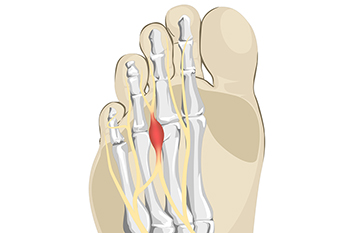Items filtered by date: August 2022
Complications of Morton’s Neuroma

Morton’s neuroma is a potentially uncomfortable and painful condition that primarily affects the nerves in one’s feet. This condition occurs when the nerve between the third and fourth toe becomes damaged. Although it is significantly less common, Morton’s neuroma can also affect the nerve between the second and third toe. The precise cause of Morton’s neuroma is still not fully known. However, footwear that is too tight and forces your toes into abnormal positions is generally thought to increase your risk of developing Morton’s neuroma. If you have Morton’s neuroma, you might find it more difficult to walk. Additionally, activities that require putting pressure on the feet can cause sharp or shooting pains. For example, someone with Morton’s neuroma may find it especially difficult to use the affected foot to press down the gas pedal when driving. Lastly, wearing high heels might prove to be especially uncomfortable or painful for someone with Morton’s neuroma. If you believe that you have this condition, please contact a podiatrist to treat the problem.
Morton’s neuroma is a very uncomfortable condition to live with. If you think you have Morton’s neuroma, contact our doctor, DPM of the city. Our doctor will attend to all of your foot care needs and answer any of your related questions.
Morton’s Neuroma
Morton's neuroma is a painful foot condition that commonly affects the areas between the second and third or third and fourth toe, although other areas of the foot are also susceptible. Morton’s neuroma is caused by an inflamed nerve in the foot that is being squeezed and aggravated by surrounding bones.
What Increases the Chances of Having Morton’s Neuroma?
- Ill-fitting high heels or shoes that add pressure to the toe or foot
- Jogging, running or any sport that involves constant impact to the foot
- Flat feet, bunions, and any other foot deformities
Morton’s neuroma is a very treatable condition. Orthotics and shoe inserts can often be used to alleviate the pain on the forefront of the feet. In more severe cases, corticosteroids can also be prescribed. In order to figure out the best treatment for your neuroma, it’s recommended to seek the care of a podiatrist who can diagnose your condition and provide different treatment options.
If you have any questions, please feel free to contact our office located in city, NA . We offer the newest diagnostic and treatment technologies for all your foot care needs.
What Does a Podiatrist Treat?

A podiatrist is a specialized doctor whose main concern is the health of your ankles, feet and toes. Podiatrists can help improve mobility, relieve pain, and treat infections. They often play a role in treating chronic conditions, such as diabetes, which can adversely affect the feet. A podiatrist can offer advice on proper foot care and selecting footwear that fosters healthy feet and ankles. They also can create custom orthotic shoe inserts that work specifically to counteract any foot, gait, or other abnormalities you may have. Among the many conditions that a podiatrist can treat are ingrown toenails, corns and calluses, flat feet, bunions, plantar warts, and heel pain. In addition, podiatrists conduct surgery, reset broken bones, prescribe medications, and order lab tests, X-rays, and imaging tests. Podiatrists attend special podiatry colleges for four years and work in hospitals for three more years. They also get advanced certifications to perform surgery on feet and ankles and acquire the title of Doctor of Podiatric Medicine, or DPM, after their name. For help with your ankle, foot or toe problems, please make an appointment with a podiatrist.
If you are experiencing pain in the feet or ankles, don’t join the stubborn majority refusing treatment. Feel free to contact our podiatrist from the city. Our doctor can provide the care you need to keep you pain-free and on your feet.
What Is a Podiatrist?
Someone would seek the care of a podiatrist if they have suffered a foot injury or have common foot ailments such as heal spurs, bunions, arch problems, deformities, ingrown toenails, corns, foot and ankle problems, etc.
Podiatric Treatment
A podiatrist will treat the problematic areas of the feet, ankle or lower leg by prescribing the following:
- Physical therapy
- Drugs
- Orthotic inserts or soles
- Surgery on lower extremity fractures
A common podiatric procedure a podiatrist will use is a scanner or force plate which will allow the podiatrist to know the designs of orthotics. Patients are then told to follow a series of tasks to complete the treatment. The computer will scan the foot a see which areas show weight distribution and pressure points. The podiatrist will read the analysis and then determine which treatment plans are available.
If you have any questions please feel free to contact our office located in City, NA . We offer the newest diagnostic and treatment technologies for all your foot and ankle needs.
Do You Have Ugly Toenails?

If you have ugly toenails, the cause might be toenail fungus. Many adults have it, particularly as one ages. This unsightly condition is especially common among those who go barefoot in public swimming areas, locker rooms, and who sweat inside their shoes for many hours in a day. The medical term for toenail fungus is onychomycosis. It is a condition that generally starts out as a white or yellow spot under the nail. While it is easy to ignore in the beginning stages, the toenail later begins to thicken, discolor, and crumble. The longer you wait to treat this, the longer it takes to get rid of it. The fungus that causes toenails to be affected is the same type of fungus that causes athlete’s foot. The two can happen concurrently if the fungus affects the skin around the infected nail. The toenail also may become painful and emit a foul odor. Those with diabetes or a suppressed immune system need to be especially cautious of toenail fungus because it can affect the blood circulation to the feet. If you suspect that you have toenail fungus, it is suggested that you see a podiatrist as soon as possible so that the condition can be treated before it spreads or becomes entrenched to the point of taking years to heal.
For more information about treatment, contact our doctor, DPM of the city. Our doctor can provide the care you need to keep you pain-free and on your feet.
Toenail Fungus Treatment
Toenail fungus is a condition that affects many people and can be especially hard to get rid of. Fortunately, there are several methods to go about treating and avoiding it.
Antifungals & Deterrence
Oral antifungal medicine has been shown to be effective in many cases. It is important to consult with a podiatrist to determine the proper regiment for you, or potentially explore other options.
Applying foot powder on the feet and shoes helps keep the feet free of moisture and sweat.
Sandals or open toed shoes – Wearing these will allow air movement and help keep feet dry. They also expose your feet to light, which fungus cannot tolerate. Socks with moisture wicking material also help as well.
If you have any questions please feel free to contact our office located in city, NA . We offer the newest diagnostic tools and technology to treat your foot and ankle needs.
